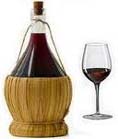Growing, Drying and Using Herbs - 3
from Italian Traditional Food
Even more about Growing, Drying and Using
Herbs
Check out these great Italian ideas at Amazon for Italian food and kitchen ideas.
<<
Previous Page
3
Continuing the short article on growing, drying and using
herbs...
The following are more unusual herbs
Balm
The aromatic foliage of this perennial plant smells of lemon. It is seldom used in cooking, but
a large handful of fresh or dried balm, infused in boiling water, makes a good tisane (tea).
Basil (sweet)
This half-hardy annual is especially good for flavouring tomato dishes. It is spicy and
fragrant, with a bright green leaf.
Caraway
Like coriander this biennial is grown for the seeds. These are used mostly dried, in cake
mixtures and bread doughs.
Chervil
This annual is frequently coupled with tarragon to add to sauces and dressings. It has a bright
green, delicate curly leaf with pronounced flavour. Chervil has value in soups where, for example, small sprigs are
used to garnish a potato soup. It can also be used in omelets and salads.
Coriander
A feathery, pretty herb to grow, this annual is grown for the seed, which is used largely for
curries and spicy dishes. It is very pungent in flavour and the seeds are generally dried before use.
Florence fennel (finocchio)
These are thick, fleshy white bulbs, crisp and juicy and tasting of aniseed. They are delicious
sliced raw in a salad, or quartered, plainly boiled, tossed in butter and served as a special vegetable.
To grow to any size, the bulbs need plenty of sunshine and moisture at the right time, so
Florence fennel is imported and appears in the shops in spring and early summer.
Hamburg parsley
Like parsley, this biennial can be treated as an annual. The plant has large sprays of leaves
similar to a carrot though not so featrhery, and the root is white like a small carrot.
Both leaves and root are used, the former chopped in stuffings and soups, notably bortsch, and
the root for grating to flavour ragouts and salads or in a bouquet garni. It can also be eaten as a vegetable, but
in this case the plants must be thinned out when half grown, like carrots.
The flavour of both leaves and root is delicate, tasting like parsley. The roots are lifted in
the autumn, like root vegetables, and may be stored.
The value of Hamburg parsley is its availability for flavouring during the winter months when
ordinary parsley is scarce.
Poppy
The seeds only are used and these are generally bought rather than grown, though poppies may be
included in the herb garden.
This poppy is the opium one (Papaver somniferum) and the seeds are used to sprinkle over bread
rolls, and in some cakes.
Page 2 of this article on herbs can be found on the previous page.
<<
Previous Page
3
Read more Italian traditional food related articles here

Copyright © 2009 -
. All Rights Reserved Worldwide. Italian Traditional Food
You may not reprint articles from this website
without the written permission of the site owner.
Disclaimer: Articles on this
Website are provided for information purposes only. Italiantraditionalfood.com does not accept any responsibility
or liability for the use or misuse of the article content on this site or reliance by any person on the site's
contents.
| 


 Digg
Digg Stumbleupon
Stumbleupon Google Bookmarks
Google Bookmarks Delicious
Delicious Twitter
Twitter Facebook
Facebook Yahoo My Web
Yahoo My Web Reddit
Reddit